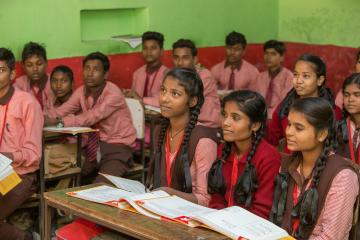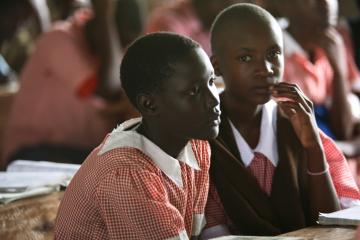
Investing in girls' education? Top 3 lessons from the evidence

How can governments, donors and implementing partners decide on where to invest to improve girls’ enrollment? Global evidence on effective interventions can be a great place to start. We highlight three key lessons everyone should keep in mind on keeping girls in school.
This article was originally posted on Global Partnership for Education on October 11, 2021.
At this year’s Global Education Summit, GPE partner countries and the global community pledged to invest in girls’ access to education.
With commitments now affirmed, and still in the midst of the COVID pandemic, governments, donors and the international community will need to choose programs to fund to build back better for girls. Rigorous evidence from randomized evaluations can maximize the impact of donor funding.
Why care about evidence?
Evidence of effective approaches from across the world can provide a menu of promising interventions to invest in. More specifically, randomized evaluations can tell us which programs have successfully increased enrollment for girls and which have not, often with surprising results. For example, impact evaluations have shown that in some contexts increasing spending on school books and computers has not increased school participation.
Cost-effectiveness analyses can also sheds light into intervention that have yielded high returns when applied in the right context. Some of the most cost-effective school participation programs tested so far address child health issues, such as intestinal worms and chronic anemia.
Evidence from global impact evaluations, combined with contextual knowledge, can also support intervention design to maximize impact.
Having identified the interventions that work, we can pair evaluations with local contextual data to understand if such interventions can be replicated in the local context and how. For example, J-PAL Africa is currently working in Nigeria to design an evidence-based life skills program in collaboration with the World Bank, the Federal Ministry of Education and Health, the State Ministry of Education in Katsina, and the Gender Innovation Lab.
We are using evidence from randomized evaluations of 36 life skills interventions to design a program informed by global lessons.
What does the evidence tell us about how to increase enrollment among girls?
There are three key lessons donors and governments should keep in mind when thinking about what interventions to invest in to keep girls in school.
1. Interventions that reduce the costs of education are particularly effective at increasing girls’ enrollment.
While most countries have eliminated tuition fees for public primary schools, fees for secondary schools are more common. Even when there are no fees, parents often still have to pay for uniforms, textbooks and school supplies.
Interventions that remove even small costs to schooling can be very effective at increasing enrollment and attendance. In Kenya, school uniforms cost about US$6 each, which is equivalent to 1.6% of the local average annual household income.
While uniforms are not officially required, students face intense social pressure to wear them to school. Sixth-grade girls who received free uniforms for two years were 16.5% less likely to drop out after three years than their peers who did not receive uniforms.
Increasing the supply of schools in areas of limited availability can be particularly effective for girls. Setting up community-based schools in remote areas in Afghanistan decreased school travel time, increasing enrollment in formal schools. In particular, girls’ enrollment rates increased compared to boys’ and the enrollment gap between girls and boys fell from 21% to 4%, almost eliminating the gap in that context.
The program also delivered 2.61 additional years of schooling per US$100 spent.
2. Changing girls’ and parents’ perceptions about the benefits of education and improving aspirations can lead to greater investments in education
Programs that address perception gaps or make the benefits of education more salient have changed behavior at low cost. When making decisions about investing in education, parents and students must weigh the expected costs and benefits. However, costs are usually immediate while benefits can be hard to judge and are often not top-of-mind.
By reframing the benefits of education, some evaluated programs resulted in increased attendance. In India, researchers tested the impact of sending recruiters to hold information sessions for women about available jobs in the business process outsourcing (BPO) industry.
Women aged 18 to 24 in villages that received the information were more likely to be employed in the BPO sector and girls aged 6 to 17 from those same villages were more likely to be enrolled in school. This is significant as the gains closed about 60% of the gap in enrollment between boys and girls.
Where girls have some influence in enrollment decisions, boosting their sense of self-worth and hopes for the future may also lead to improved schooling outcomes.
There is strong evidence that programs for adolescent girls which included soft and life skills training components, sometimes bundled with other interventions, improved their sense of self-efficacy and gender attitudes. The majority of these evaluations targeting enrolled girls also found positive impacts on schooling.
For example, the Educate! program, a life skills intervention program, delivered soft skills training focused on job readiness (including communication, teamwork, self-confidence, critical thinking, creativity and grit) paired with hard skills like business planning, budgeting and saving in the last two years of secondary school. This led to improved completion rates among girls; girls were also 11% more likely to be enrolled in tertiary education.
3. But more research is needed to unpack gender-specific barriers to education
Although girls tend to benefit most from general enrollment interventions, we still don’t know enough about gender-specific barriers to education.
Governments and their partners point to many possible reasons for high rates of school dropout, including child marriage and adolescent pregnancy, in-school gender-based violence, unfavorable gender norms on girls’ schooling, and gender-insensitive pedagogy.
These issues tend to predominantly affect adolescents. In fact, across many countries in sub-Saharan Africa, we see a steep decline in enrollment for girls and widening gender gaps between primary and secondary school.
However, more evidence is needed to understand how gender-specific barriers affect girls’ enrollment and which interventions can effectively stem these issues:
- While some interventions have successfully reduced child marriage and early pregnancy as well as gender-based violence, we know little about the causal effects on enrollment and how to effectively deliver these programs through school infrastructure.
- Although evidence suggests that we can shape gender norms, there is limited rigorous research on interventions that seek to shape norms on girls’ schooling.
- Finally, while initial studies suggest that certain learning practices may affect girls differently than boys, additional research will help us understand whether these practices can bridge learning gaps and how to integrate them into education systems.
Evaluating innovative programs on these topics will help bridge evidence gaps and equip policymakers and their partners with insights to make informed decisions on which programs and policies to invest in.
At J-PAL Africa, we have raised our hand to support governments and implementing partners interested in engaging with the evidence, either for policy design or to evaluate new and exciting programs to boost girls’ school participation and empowerment.
If you are interested in learning more about how we can support you, please follow us @JPAL_Africa, sign up for our newsletter or contact us directly at [email protected].


